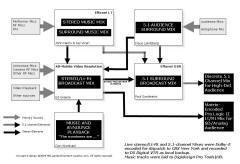|
Audio Production for 47th Grammy
|
|
New Audience Reaction and
DTV Mix Written by Mel Lambert in February 2005 |
The
recent 47th Annual Grammy Awards, hosted by Queen Latifah, represented an
excellent opportunity to showcase the industry’s leading musical artists, while
ensuring that the viewing audience was caught up with memorable performances
from such acts as The Black Eyed Peas, Gwen Stefani, Green Day, U2, Melissa
Etheridge, Kanye West with Mavis Staples and John Legend, The Blind Boys of
Alabama, Usher and more. The night's big winner was Ray Charles & Various
Artists' Genius Loves Company, picked for Album of the Year, Best Engineered
Album and Best Surround Sound Album, with “Here We Go Again” named Record of the
Year. Al Schmitt added to his Grammy collection, serving not only as engineer on
Genius Loves Company and co-engineer for “Here We Go Again,” but also as the
album's Surround Mixer.
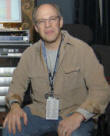 And NARAS has placed an increasing emphasis on broadcasting the event in not
only stereo for the majority of the TV audience, but also allowing owners of
surround-sound rigs to enjoy the enveloping experience of a carefully crafted
5.1-channel mix. For the 47th Grammy Awards, broadcast live from the Staples
Center, Los Angeles on Sunday, February 13, co-sound supervisors Phil Ramone and
Hank Neuberger (pictured right) extended the creative envelope with some innovative strategies.
Working closely with Ramone and Neuberger were veteran sound designer Murray
Allen, plus 5.1 consultant and Effanel CEO, Randy Ezratty. Executive producers
for the show were Ken Erlich and John Cossette; director was Walter Miller.
And NARAS has placed an increasing emphasis on broadcasting the event in not
only stereo for the majority of the TV audience, but also allowing owners of
surround-sound rigs to enjoy the enveloping experience of a carefully crafted
5.1-channel mix. For the 47th Grammy Awards, broadcast live from the Staples
Center, Los Angeles on Sunday, February 13, co-sound supervisors Phil Ramone and
Hank Neuberger (pictured right) extended the creative envelope with some innovative strategies.
Working closely with Ramone and Neuberger were veteran sound designer Murray
Allen, plus 5.1 consultant and Effanel CEO, Randy Ezratty. Executive producers
for the show were Ken Erlich and John Cossette; director was Walter Miller.
“In previous years,” Neuberger explains, “we had provided a single remote
[truck] to handle the generation of both stereo and 5.1-channel music mixes,
which were passed to Ed Greene in the video-production mobile, to be
incorporated into the broadcast mixes. This year we realized that, because of
the accelerating interest from DTV-equipped home viewers, we didn’t want to
generate a plain-vanilla stereo mix at all. Instead, we decided to create a
[matrix-encoded 5:2:5 Dolby Pro Logic II] Lt-Rt mix for standard-definition
viewers, and a totally independent, discrete 5.1-channel mix for HD viewers.
“For the latter, we considered that a single mixer just could not handle
everything. And, since the show’s long-time producers [Cossette Productions]
wanted to ensure that the sound of the audience was fully integrated into both
the stereo and surround mixes, we laid on a separate environment where the
outputs from almost 40 audience mics could be blended into a number of separate
stem elements. In addition, following its successful use at the recent Super
Bowl broadcast, we rigged a Holophone microphone [close to the front-of-house
mixing position] to provide a single-source surround sound pickup.
“All in all, I think that the combination of the new additional facilities
helped to ensure a more vivid and encompassing surround mix than we have
achieved in previous broadcasts.”
Audio coordinator on the production, responsible for making recommendations on
equipment and audio solutions, was Michael Abbott, who managed a team of 65+
audio technicians during rehearsals and the live broadcast, working across three
performance stages and orchestral areas. “The show was a huge collaborative
effort,” Abbott considers. “It was my role to marshal our talented crews into a
cohesive whole so that everybody was working to a common goal.”
On-stage wired and RF mics plus wireless monitors comprised a mixture of AKG,
Audio-Technica, Neumann, Sennheiser and Shure models. Dave Bellamy’s
Soundtronics company provided a number of Sennheiser SKM5000-N wireless
handhelds fitted with Neumann KK105-S elements; Evolution wired mics were
selected by several artists for vocals and backline milking, along with Neumann
TLM103 large-diaphragm mics for the orchestra. Audio-Technica’s Artist Elite
5000 Series and Shure UHF/SM58 wireless models also were used. The total mike
count, according to Abbott, was close to 450, with some 6,000 audio patches made
and remade during the rehearsals, dress and air show.
Five Primary
Audio-Production Areas at Staples Center
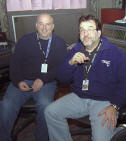 As can be seen from
Figure 1, shown left,
there were five primary audio-production areas. Microphone and DI sources from
the on-stage performers and orchestra were routed via splitters to both the FOH
and monitor-mix positions, as well as the Effanel L7 truck parked backstage. A
total of 12 Aphex eight-channel Model 1788 remote-controlled pre-amps/A-to-Ds
connected to L7 via a multiway MADI digital umbilical from the stages. Within
the truck, seasoned veterans John Harris and Jay Vicari (pictured
right) handled the stereo and
surround sound music mixes on an AMS Neve Capricorn digital console. Harris and
Vicari alternated mixing duties during rehearsals and the live performances.
As can be seen from
Figure 1, shown left,
there were five primary audio-production areas. Microphone and DI sources from
the on-stage performers and orchestra were routed via splitters to both the FOH
and monitor-mix positions, as well as the Effanel L7 truck parked backstage. A
total of 12 Aphex eight-channel Model 1788 remote-controlled pre-amps/A-to-Ds
connected to L7 via a multiway MADI digital umbilical from the stages. Within
the truck, seasoned veterans John Harris and Jay Vicari (pictured
right) handled the stereo and
surround sound music mixes on an AMS Neve Capricorn digital console. Harris and
Vicari alternated mixing duties during rehearsals and the live performances.
“During rehearsals we recorded the [pre-fader] signals to
[Digidesign] Pro Tools|HD,” Harris recalls, “and then used the tracks to refine
our Capricorn EQ and automation [settings] during evening playback sessions.”
“In that way,” Vicari continues, “we could develop automated stereo and surround
mixes, which helped us [develop] the multiple balances we would need during the
on-air broadcast.” Also on hand in the L7 Remote, supervising the music
balances, was Academy advisor Neuberger; Phil Ramone, who served as the
Academy’s overall music producer for the Grammy Awards, monitored the broadcast
mix in the All-Mobile Video Resolution Truck with Ed Greene.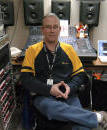
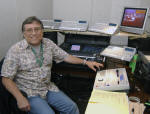 Klaus Landsberg (pictured left) – an experienced broadcast mixer from such shows
such as “American Idol” and “The Ryan Seacrest Show” - was hired for the sole
purpose of mixing the audience microphones. Landsberg helmed a backstage
Audience Surround Mix Area equipped with a Yamaha PM2000 digital console, close
to where Don Worsham
(pictured right)
triggered a variety of pre-recorded announcements and music
clips for the awards section of Grammy presentations. Worsham used a number of
360 Systems Instant Replay and DigiCart systems linked to a Yamaha 02R digital
console. The final 5.1-channel mix for the DTV HiDef viewing audience was
handled by Paul Sandweiss in the Effanel OSR Mobile parked backstage.
Klaus Landsberg (pictured left) – an experienced broadcast mixer from such shows
such as “American Idol” and “The Ryan Seacrest Show” - was hired for the sole
purpose of mixing the audience microphones. Landsberg helmed a backstage
Audience Surround Mix Area equipped with a Yamaha PM2000 digital console, close
to where Don Worsham
(pictured right)
triggered a variety of pre-recorded announcements and music
clips for the awards section of Grammy presentations. Worsham used a number of
360 Systems Instant Replay and DigiCart systems linked to a Yamaha 02R digital
console. The final 5.1-channel mix for the DTV HiDef viewing audience was
handled by Paul Sandweiss in the Effanel OSR Mobile parked backstage.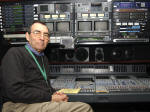
Meanwhile, in the rear of the Resolution Truck,
Ed Greene
(pictured right)
handled
the Lt-Rt surround broadcast mix – including production announcements and audio
playback from pre-recorded video sources, in addition to incorporating the
stereo music produced by Harris and Vicari in L7, and various audience stems
from Landsberg. According to Greene, the latter comprised a stereo-front,
stereo-rear and on-camera mikes. “I had a foot control that enabled me to add a
pre-mixed audience balance, according to audience reactions within the Stapes
Center.” says Greene.
The resultant matrix-encoded ProLogic II two-channel broadcast mix
contained left, center and right assignments, plus stereo surrounds. “Although I
was creating a 5.0 mix, I needed to ensure full compatibility with existing
stereo and mono receivers being used by the majority of viewers,” Greene
acknowledges.
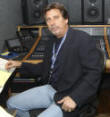 According to 5.1 surround mixer
Paul
Sandweiss
(pictured left), the idea to mike the
audience areas came from a series of conversations with the show's producer and
NARAS about the importance of covering live audience reactions. “[Producer] Ken
Ehrlich was so impressed with the sound of the audience in a post-production mix
[for a previous show at the Staples Center] that he requested special
arrangements be made for the Grammy Awards,” Sandweiss says. To capture the
enthusiastic response of the various artists' fans and radio station promo
winners, multiple mics were positioned at a number of locations throughout the
Staples Center’s seating areas.
According to 5.1 surround mixer
Paul
Sandweiss
(pictured left), the idea to mike the
audience areas came from a series of conversations with the show's producer and
NARAS about the importance of covering live audience reactions. “[Producer] Ken
Ehrlich was so impressed with the sound of the audience in a post-production mix
[for a previous show at the Staples Center] that he requested special
arrangements be made for the Grammy Awards,” Sandweiss says. To capture the
enthusiastic response of the various artists' fans and radio station promo
winners, multiple mics were positioned at a number of locations throughout the
Staples Center’s seating areas.
Within the dedicated Audience Surround Mix Area, Landsberg had access to the
output from some 40 audience mics - primarily Neumann KM184 cardioid and TLM100
models, Sennheiser MKH416 shotguns mounted on HiDef cameras, plus AKG C547
boundary-layer mics across the stage apron - and a Holophone H2-PRO that had
been placed approximately 30 rows back from the front of the stage and some 15
feet in the air, with the head pointing towards the stage. “The
[Holophone-derived] multi-channel ambience was used to feed the main surround
ambience mix for the entire 5.1 broadcast,” Landsberg explains. “The natural
sounding 5.1 ambience [from the H2-PRO] added a realistic dimensional space to
the tightly-produced live show, providing HDTV viewers with an added and
complete sense of ‘being there’.” Landsberg provided surround mixer Sandweiss
with an eight-channel stem of stereo-front, stereo-rear, stereo balcony and
stereo front-of-stage, close to the Mosh Pit area.
“I’m a big fan of the [Neumann] KM184,” the engineer adds. “It is a very smooth
sound, offers a lot of dynamic range - it doesn’t overload, which is very useful
when you are covering energetic audience sections - and produces a rich sounding
output. It’s definitely my favorite audience mike.” Landsberg also had access to
a Cedar DNS1000 Dynamic Noise Suppressor, which “helped take the reverb decay
and slap out of the room - there are huge standing waves coming out of the
[Staples Centers] boxes.”
“After the show,” recalls audio coordinator Abbott, “I received a call from the
Grammy producers who said they were thrilled with the audience response we
captured for this show. It was the first time in 10 years that the producers got
exactly what they wanted. Putting 184s and 416s throughout the audience made
quite a difference - they delivered the audience response in the Staples Center
better than any other mics we've used in the past.”
For audio monitoring, most areas featured Genelec or JBL powered monitors. JBL
Professional supplied a number of LSR6300 Series loudspeakers so that 5.1 mixes,
stems and elements would be created using the same sonic reference. The system’s
RMC Room Mode Correction enabled accurate adjustment of low-frequency response
in each room. Sandweiss was provided with five LSR6325P monitors and an
LSR6312SP Subwoofer, plus a pair of LSR6325P units for stereo solo, while
Landsberg’s Surround Mix Area boasted five LSR6328P monitors, an LSR6312SP sub
plus two LSR6328P for solos.
Various Dolby Laboratories hardware used during the production included a model
DP563 Pro Logic II encoder and DP564 Pro decoder, DP571 Dolby-E encoder and
companion DP572 decoder, plus an LM100 Loudness Meter and Eight-channel Metering
unit in Sandweiss’ mix room for monitoring the Dolby E stream as an audio
source.
A number of signal processing and multiband dynamics control were also available
in the various production areas. Within the Effanel L7 music-mixing truck, a
Lexicon 960L and TC Electronic System 6000 were on-hand for ambience generation;
in the Audience Surround Mix Area, Landsberg utilized a Mastering 6000 across
component L, R, Left-Surround and Right-Surround stems to add coherence using
the 6000's upward multiband compression.
In the Effanel OSR truck that provided a final 5.1 surround mix for the HighDef
uplink, a System 6000 provided additional reverb, while a TC DB-8 Digital
Television Processor provided final audio compression for Sandweiss' mix prior
to Dolby E encoding. “Every project that leaves my studio goes through the DBMax
or the P2,” Sandweiss offers, “so it’s logical that I would use the DB-8 on such
a critical 5.1 broadcast.” Finally, within the All-Mobile Video truck, Greene
had access to a TC Finalizer and DBMax to level control his final two-channel
Pro Logic II-encoded broadcast mix. (Reportedly, TC Electronic reverbs and
stereo on-air processing have been used on Grammy Award broadcasts since 2001.)
Reflecting on the experience, co-sound supervisor Neuberger considers the 47th
Grammy Awards a resounding success. “It was far more complex than anything we
have encountered [in previous years],” he offers, “but there were very few
technical problems. It was a major accomplishment to make the audio sound as
good as it did for the show’s television audiences around the world.”
![]()
©2025 Media&Marketing. All Rights Reserved. Last revised:
01.04.25
